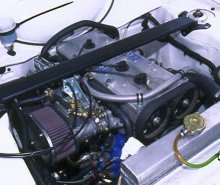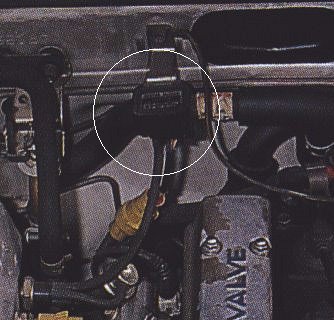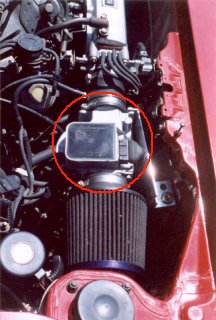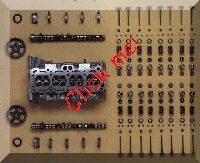
Welcome, from sunny Australia!
The Stock 4AGE Description Page

The Stock 4AGE Description Page
In this page I talk in some detail about
the different types of 4AGE, and a little about which cars they come in.
The Toyota 4AGE engine started life in 1983
as a logical progression from the 2A and 3A single cam engines. There
was also the single cam 4A-C engine, which initially shared an
identical block & very similar internals as the twin cam version.
The 4AGE soon progressed to having stronger internals, and so they
diverged from there.
The twin cam 4AGE is basically a road going,
mass produced version of the Ford Cosworth BDA twin cam racing engine.
They share the same bore and stroke (81mm x 77mm), the same size valves
(29.5mm & 25.5mm), and in some versions of the 4AGE very similar
port shapes & sizes. When fully prepared for racing, they both
produce similar hp figures at similar revs, so it would seem that
Toyota
has done an excellent job with them.

The parallels continue - The 4AGE is the first twin cam that Toyota made with a rubber drive belt for the camshafts, as was the BDA. The 4AGE was a development of the single cam 2A, 3A. & 4A engines, but I guess Toyota must have planned to make the 'A' series engine into a twin cam, perhaps again following the 'A' series Cosworth engines.


The total variants of the
4AGE are, to the best of my knowledge -
- Very early big port TVIS 16
valve, with black lettering & 6-bolts holding the flywheel on.
- Big port TVIS FWD/RWD 16
valve, usually with blue lettering on the cam cover and 'TVIS' on the
inlet plenum.
- Big port TVIS FWD 16 valve,
with red lettering. They have a seven-rib block with oil-squirters.
- Small port non-TVIS FWD
valve.
- Silvertop 20 valve. Early
& late type, minor variations in inlet system & VVT operation.
- Blacktop 20 valve.
- Early supercharged 4AGZE,
low compression big port head, distributor.
- Mid-aged supercharged
4AGZE, higher compression big port head, crank angle sensor type
ignition.
- Late supercharged 4AGZE,
higher compression small port head, crank angle sensor type ignition.
More information on these
engines below.
The first
4AGE, RWD & FWD
Anyway, the 4AGE started life as a twin cam
head fitted to the single cam bottom end, though the crank was a bit
stronger, the pistons also stronger, and a windage tray fitted between
the sump and the block. The clutch and clutch plate are identical as
the single cam 4A model.
The versions with MAP (Manifold Absolute
Pressure) sensors make 127hp in standard trim, and red-line at 7700rpm.
Some countries have the AFM (Air Flow Meter) sensor versions, which
make 115hp. So how to tell the two apart? Well, the MAP sensor
versions have a small black box that is attached to the inlet manifold
by a rubber pipe. (This pipe lets the sensor sample the inlet manifold
air pressure) The MAP sensor usually sits on the firewall, and looks
like this -


Brief
summary of the different types
4AGE's come in both front and rear wheel
drive form, and although they are very similar, there are a number of
small differences that make swapping them over not quite as easy as
it would first seem. I won't be getting into that area, as a good
friend of mine, Phil Bradshaw, has already written an excellent page on doing just that. Please note that
the engine types described here in the next few page are of Japanese
production, other countries may vary on these specs slightly.
With the RWD types, they came out in big
port versions only - no small ports - in basically two types as
mentioned in the previous paragraph. These can be found in the AE-86
Corolla and AA-63 Celica, with the AFM one having 115hp and the ones
with MAP sensors having 127hp. The FWD ones are much the same, coming
in the AE-82 Corolla, but with the AE-92 Corolla the small port 4AGE
(non-TVIS) made its debut, with 100kw or 134hp.
Two odd types -
- I have also heard that there was a very early (1983) and now rare
4AGE TVIS FWD that had black lettering on the cam cover, but the main
difference is that the crank only has six flywheel bolts verses all
the other 4AGE's that have eight and so it looks like it has a 4A-C
single-cam type crankshaft.
- Another odd 4AGE is one that has red lettering on the top, is
fitted with TVIS & a big port head, but has a seven-rib block &
a 42mm bearing crank. There are much easier to find around the
world. They also appear to have no oil squirters on the inside of the
block, unlike the regular small port types which do.
With the arrival of the AE-101,
things changed a great deal; The naturally aspirated 16v 4AGE was no
more - replaced by the new 20v 4AGE - and another newcomer was the
supercharged 4AGZE. The 20v started with a claimed 165ps and the blown
16v 145hp, though the 'Z' had a great deal more torque, but was a
lot less 'revvy'.
The AE-101 came with the slightly improved
claimed 170ps 20v 4AGE, and there was also the options of two 4AGZE's,
both with 165ps. (The later one having an integrated ignition coil
pack system)
Many people seem to define the different
types of 4AGE by the colour of the letters on the cam cover, but I
think
that this is not a reliable method, as from what I've seen different
countries have different colours, cam covers have been repainted, and
sometimes swapped. I only recognise the different types by them being
a big or small port, RWD or FWD, AFM or MAP, and the number of valves.
4AGE Head
Types
There are two types of 16 valve heads, and
the one 20 valve - The majority of 16v 4AGE's have what's called the
'big port' head, and the remainder (only found on the AE-92 FWD
Corolla) have the 'small port' head. The small port head is the
prefered type for performance in a road car, as they are easier to get
up to about 200hp out of. (More than about 200hp the big port is best)


This is what the combustion chambers look like ...

... and they are quite efficient, able to make a good 100hp/litre with very few mods

Here is a cross-sectioned 16v head
The rest of the head is much advanced
over the 'old' BDA, in that it is a single piece design and it also
doesn't require to have the camshafts removed to get to the shim
adjusters when working on the valve clearances. (The BDA's head comes
in two large pieces, and it splits horizontally just below the cam
bearings to make it possible to get to the shim adjusters. This makes
the head castings a LOT more expensive, less accurate, and
potentially unreliable)
The 4AGE's use a 'shim over bucket' system
for valve clearances, and by doing this it allows you to alter the
valve
clearances without removing the cams, unlike just about every other
twin
cam engine. Note that Toyota want you to use a 'special tool' to get
the shims in & out with, but it's easy enough to do it with a
couple of small screwdrivers to push the bucket down with.

16v 4AGE heads specifications -
- Valve included angle (angle between the
inlet and exhaust valves) - 45°
- Minimum valve spring seat pressure to
allow for 7,700rpm - 35lbs, or 16kgs
- Inlet valve diameter - 29.5mm
- Exhaust valve diameter - 25.5mm
- Both valves have 6mm diameter stems.
- Cam bucket diameter 28mm, shim diameter 25mm
| Cam Timings - (Japanese spec) | Inlet Cam | IVO BTDC | IVC ABDC | Duration |
Lift (mm) |
| 'Big port' | 9° | 51° | 240° |
7.56 | |
| 'Small port' | 8° | 44° | 232° | 7.1 | |
| 4AGZE | 8° | 44° | 232° |
7.1 | |
| Exhaust Cam | EVO BBDC | EVC ATDC | |||
| 'Big port' | 51° | 9 ° | 240° |
7.56 | |
| 'Small port' | 44° | 8° | 232° |
7.1 | |
| 4AGZE | 44° | 8° | 232° |
7.1 |
The 20v head is a very different beast
indeed!
The obvious difference is that they have
three small inlet valves instead of the more common two. This is
intended to give the engine better breathing, and as the 20v is about
145hp it seems to work. For lots more pictures of the 20v head, please
check out the second page of my 4AGE Mods
page.
20v 4AGE head specifications -
- Valve included angle (angle between the
inlet and exhaust valves) - 35° (I think ...)
- Inlet valve diameter - 26.5mm
- Exhaust valve diameter - 26mm
- Both valves have 5mm diameter stems
- Cam bucket diameter 23mm, with very small shims between the valve
stem top & bucket
| Cam Timings - (AE101) | Inlet Cam | IVO BTDC | IVC ABDC | Duration |
Lift (mm) |
| VVT <4400rpm & >~7000rpm | 0° | 70° | 250° |
7.97 | |
| VVT >4400rpm | 30° | 40° | |||
| Exhaust Cam | EVO BBDC | EVC ATDC | 250° |
||
| 54° | 16° | 7.6 |
| Cam Timings - (AE111) | Inlet Cam | IVO BTDC | IVC ABDC | Duration |
Lift (mm) |
| VVT <4400rpm & > ~7000rpm | 5° | 65° | 250° |
8.2 | |
| VVT >4400rpm | 35° | 35° | |||
| Exhaust Cam | EVO BBDC | EVC ATDC | |||
| 54° | 16° | 250° |
7.6 |
(See the '4AGE Other Stuff ' section for more details of the VVT system, and also my ' VVT Vs VTEC ' pages for a complete description)
And on another page -
- 4AGE
Oil System, 4AGE Water System, 4AGE EFI, 4AGE Other Stuff
Back to
the Index page
Page & contents where applicable © Bill Sherwood